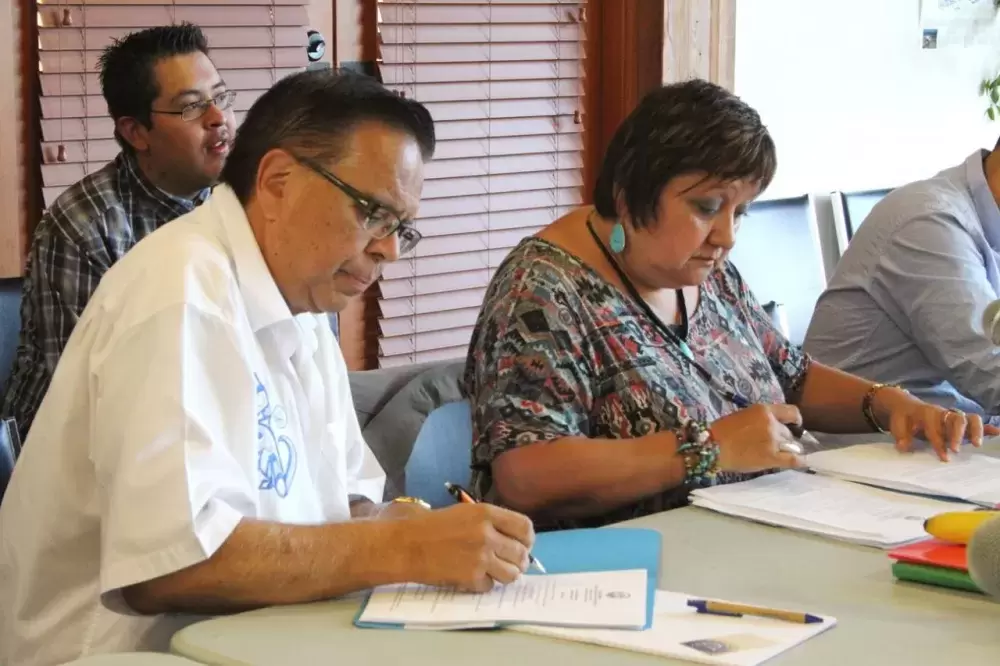Nuu-chah-nulth Nation leadership has gathered today at Tseshaht First Nation to develop a Nuu-chah-nulth-specific strategy around the recent Supreme Court of Canada Tsilhqot’in decision, a landmark ruling that was the first ever to acknowledge Aboriginal title exists and it exists here in British Columbia.
Nuu-chah-nulth leaders will learn what the decision means to their territories, share concerns and current strategies around resource development, and discuss ways to employ the Tsilhqot’in decision for the future benefit of the people.
After a chant by Robert Watts and the singing of the Nuu-chah-nulth Song, led by Cliff Atleo, Tseshaht Chief Councillor Hugh Braker welcomed the leaders to the territory. He explained how the meeting on this important decision had come about.
A lawyer of considerable influence over many years, Braker was quick to realize that the Tsilhqot’in decision would have a real and profound impact on the operations of Tseshaht. Within days of the Supreme Court releasing its decision, Braker had analyzed the ruling and pulled together a webcast to talk about its implications.
A couple of weeks ago, Braker attended a meeting where 250 B.C. chiefs gathered to learn more about the Tsilhqot’in decision, but he decided Nuu-chah-nulth needed to drill down to learn how to use the decision back home. He approached Debra Foxcroft, president of the Nuu-chah-nulth Tribal Council, and other Nuu-chah-nulth leaders and all were enthusiastic about pulling today’s meeting together. It was originally planned for non-treaty Nuu-chah-nulth nations, but Maa-nulth treaty nations expressed interest in learning more, so the meeting was opened to include them.
Braker said the nations can learn from one another. Many are being faced with big projects in their traditional territories, including large mine operations. Many are dealing with ongoing forestry concerns. Braker said he’s recently received 20 applications from forestry companies hoping to expand operations in Tseshaht territory, including nine applications for log dumps which could impact Tseshaht fisheries. The discussion today will look at how Tsilhqot’in might be applied in making better decisions on such matters.
What does the ruling mean to the seabed around the Broken Islands, for example, or the renewal of agreements with governments where the requirement for consultation is being cutback, despite many court victories on the duty to consult? Braker said there are keys to unlocking a nation’s future potential within the Tsilhqot’in decision.
Facilitating the day’s discussion is Doug White III, former chief councillor of Snuneymuxw, a lawyer himself and the interim director of the Centre for Pre-Confederation Treaties and Reconciliation with Vancouver Island University. White holds a name from the Nuu-chah-nulth territory and has roots in Hupacasath. He served as part of the First Nations Summit Task Group for three years.
White has a long history of dealing with the issues before the chiefs today, said Braker.
White told the gathering he remembered the queasy feeling he had in his stomach the night before the Supreme Court made public its decision, worrying about whether the high court would uphold the “ugly” Appeals Court decision in Tsilhqot’in that basically said ‘go back to your reserves and shut up about title’.
Title was as expansive as it was going to get, said the Court of Appeal with a decision deeply rooted in denial of the First Nation’s relationship to its traditional territory, according to White. But the Supreme Court of Canada stepped outside of the court’s general impulse that saw title rights as too big and complex to deal with.
First Nations title exists, it’s living and breathing and exists beyond the village site or the rock we stand on to fish, explained White. The Supreme Court in Tsilhqot’in rejected that small and narrow view, he said.
Also presenting today is Matt Kirchner of Ratcliff and Company, the law firm that successfully represented Nuu-chah-nulth Nations in their commercial fishing rights litigation, another landmark victory. Grand Chief Stewart Phillip will be joining the discussion later. Also on the day’s agenda is Jack Woodward from Woodword and Co, the lead firm in the Tsilhqot’in decision, and Dave Haggard and Dan Smith of the BC Treaty Commission.
NTC President Debra Foxcroft also provided a welcome to the group, and acknowledged the fathers, grandfathers and great grandfathers of the past for their work around the table, fighting the good fight on what was then called “the land question”. She remembers the passionate speeches about Nuu-chah-nulth territories and the position that had brought us to this place now.
“It’s our land and we’ve never given it up.”
She thanked all the presenters for being willing to share their perspectives on the Tsilhqot’in decision, and encouraged leadership to put their minds and experience to work to come up with a Nuu-chah-nulth strategy that will propel the nations forward.
“Seize the moment,” Foxcroft said. What are the options, the things Nuu-chah-nulth-aht can do together to leverage this opportunity?







